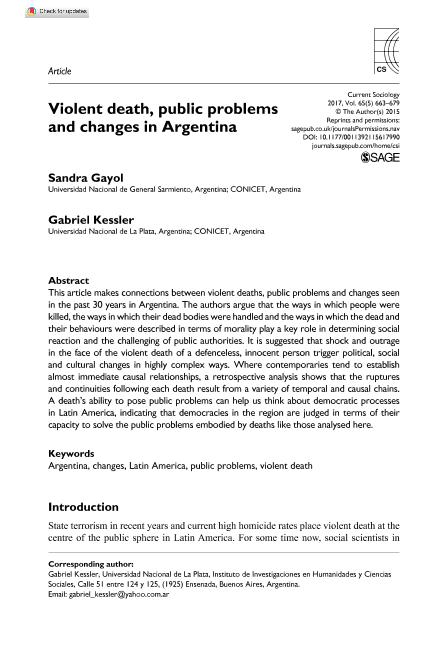Mostrar el registro sencillo del ítem
dc.contributor.author
Gayol, Sandra Viviana

dc.contributor.author
Kessler, Gabriel

dc.date.available
2018-04-17T17:15:19Z
dc.date.issued
2015-12
dc.identifier.citation
Gayol, Sandra Viviana; Kessler, Gabriel; Violent death, public problems and changes in Argentina; SAGE Publications; Current Sociology; 65; 5; 12-2015; 663-679
dc.identifier.issn
0011-3921
dc.identifier.uri
http://hdl.handle.net/11336/42294
dc.description.abstract
El artículo pone en relación muertes violentas-problemas públicos-cambios en la argentina de los últimos treinta años. Sostiene que la forma de matar, el ultraje posterior del cadáver y las versiones sobre la moralidad de la víctima fueron centrales en las reacciones sociales y en la interpelación a los poderes públicos. Sugiere que la conmoción pública por una muerte violenta a un ser indefenso e inocente deriva de manera muy compleja en cambios políticos, sociales o culturales. Si los contemporáneos a la muerte establecen una relación causal y casi inmediata, un análisis retrospectivo prueba que diversos encadenamientos temporales y causales son los que produjeron las rupturas y las continuidades acaecidas a partir de cada muerte. La capacidad de una muerte para plantear problemas públicos brinda pistas para pensar de manera diferente los procesos de transición democrática en América Latina y sugiere que las democracias latinoamericanas son evaluadas por la población a partir de su capacidad de resolver determinados problemas públicos que las muertes analizadas en este artículo tuvieron la capacidad de encarnar.
dc.description.abstract
This article makes connections between violent deaths, public problems and changes seen in the past 30 years in Argentina. The authors argue that the ways in which people were killed, the ways in which their dead bodies were handled and the ways in which the dead and their behaviours were described in terms of morality play a key role in determining social reaction and the challenging of public authorities. It is suggested that shock and outrage in the face of the violent death of a defenceless, innocent person trigger political, social and cultural changes in highly complex ways. Where contemporaries tend to establish almost immediate causal relationships, a retrospective analysis shows that the ruptures and continuities following each death result from a variety of temporal and causal chains. A death’s ability to pose public problems can help us think about democratic processes in Latin America, indicating that democracies in the region are judged in terms of their capacity to solve the public problems embodied by deaths like those analysed here.
dc.format
application/pdf
dc.language.iso
eng
dc.publisher
SAGE Publications

dc.rights
info:eu-repo/semantics/openAccess
dc.rights.uri
https://creativecommons.org/licenses/by-nc-sa/2.5/ar/
dc.subject
Violent Death
dc.subject
Publics Problems
dc.subject
Political Changes
dc.subject
Argentine
dc.subject.classification
Historia

dc.subject.classification
Historia y Arqueología

dc.subject.classification
HUMANIDADES

dc.title
Violent death, public problems and changes in Argentina
dc.type
info:eu-repo/semantics/article
dc.type
info:ar-repo/semantics/artículo
dc.type
info:eu-repo/semantics/publishedVersion
dc.date.updated
2018-04-17T13:49:17Z
dc.journal.volume
65
dc.journal.number
5
dc.journal.pagination
663-679
dc.journal.pais
Estados Unidos

dc.journal.ciudad
Nueva York
dc.description.fil
Fil: Gayol, Sandra Viviana. Consejo Nacional de Investigaciones Científicas y Técnicas; Argentina. Universidad Nacional de General Sarmiento; Argentina
dc.description.fil
Fil: Kessler, Gabriel. Consejo Nacional de Investigaciones Científicas y Técnicas; Argentina. Universidad Nacional de La Plata; Argentina
dc.journal.title
Current Sociology

dc.relation.alternativeid
info:eu-repo/semantics/altIdentifier/doi/https://doi.org/10.1177/0011392115617990
dc.relation.alternativeid
info:eu-repo/semantics/altIdentifier/url/http://journals.sagepub.com/doi/abs/10.1177/0011392115617990
Archivos asociados
